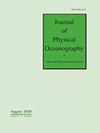Unsupervised classification identifies warm, fresh and dense regimes of the Antarctic margins
IF 2.8
2区 地球科学
Q1 OCEANOGRAPHY
引用次数: 0
Abstract
The ocean surrounding Antarctica, also known as the Antarctic margins, is characterised by complex and heterogeneous process interactions which have major impacts on the global climate. A common way to understand changes in the Antarctic margins is to categorise regions into similar ‘regimes’, thereby guiding process-based studies and observational analyses. However, this categorisation is traditionally largely subjective and based on temperature, density and bathymetric criteria that are bespoke to the dataset being analysed. In this work, we introduce a method to classify Antarctic shelf regimes using unsupervised learning. We apply Gaussian Mixture Modelling to the across-shelf temperature and salinity properties along the Antarctic margins from a high-resolution ocean model, ACCESS-OM2-01. Three clusters are found to be optimum based on the Bayesian Information Criterion and an assessment of regime properties. The three clusters correspond to the fresh, dense and warm regimes identified canonically via subjective approaches. Our analysis allows us to track changes to these regimes in a future projection of the ACCESS-OM2-01 model. We identify the future collapse of dense water formation, and the merging of dense and fresh shelf regions into a single fresh regime that covers the entirety of the Antarctic shelf except for the West Antarctic. Our assessment of these clusters indicates that the Antarctic margins may shift into a two-regime system in the future, consisting only of a strengthening warm shelf in the West Antarctic and a fresh shelf regime everywhere else.无监督分类确定南极边缘的温暖、清新和浓密系统
南极洲周围的海洋(又称南极边缘)具有复杂和异质过程相互作用的特点,对全球气候有重大影响。了解南极边缘变化的常用方法是将区域划分为类似的 "制度",从而指导基于过程的研究和观测分析。然而,这种分类传统上主要是主观的,是基于温度、密度和水深标准,而这些标准是根据所分析的数据集定制的。在这项工作中,我们介绍了一种利用无监督学习对南极大陆架系统进行分类的方法。我们将高斯混合建模应用于高分辨率海洋模型 ACCESS-OM2-01 中南极大陆架边缘的温度和盐度特性。根据贝叶斯信息标准和对水系特性的评估,发现三个簇是最佳的。这三个群组分别对应于通过主观方法确定的新鲜、密集和温暖海况。通过分析,我们可以在 ACCESS-OM2-01 模型的未来预测中跟踪这些水系的变化。我们发现,未来浓水的形成将崩溃,浓水和淡水陆架区域将合并成一个单一的淡水系统,覆盖除南极西部以外的整个南极陆架。我们对这些群集的评估表明,南极边缘在未来可能会转变为一个双水系系统,只包括南极西部不断加强的暖陆架和其他地方的淡水陆架水系。
本文章由计算机程序翻译,如有差异,请以英文原文为准。
求助全文
约1分钟内获得全文
求助全文
来源期刊
CiteScore
2.40
自引率
20.00%
发文量
200
审稿时长
4.5 months
期刊介绍:
The Journal of Physical Oceanography (JPO) (ISSN: 0022-3670; eISSN: 1520-0485) publishes research related to the physics of the ocean and to processes operating at its boundaries. Observational, theoretical, and modeling studies are all welcome, especially those that focus on elucidating specific physical processes. Papers that investigate interactions with other components of the Earth system (e.g., ocean–atmosphere, physical–biological, and physical–chemical interactions) as well as studies of other fluid systems (e.g., lakes and laboratory tanks) are also invited, as long as their focus is on understanding the ocean or its role in the Earth system.

 求助内容:
求助内容: 应助结果提醒方式:
应助结果提醒方式:


